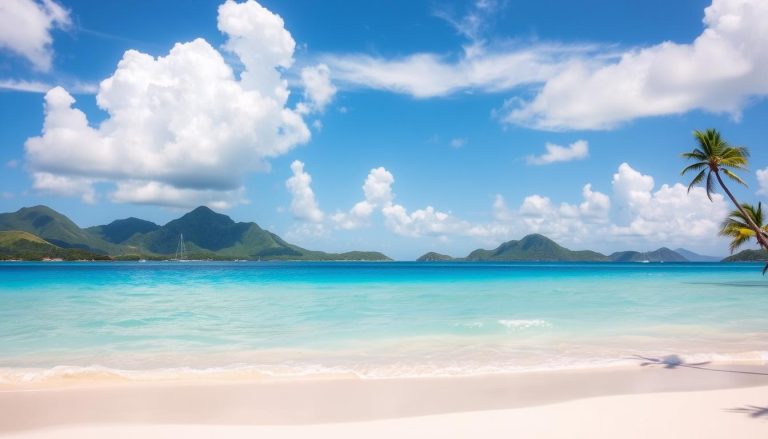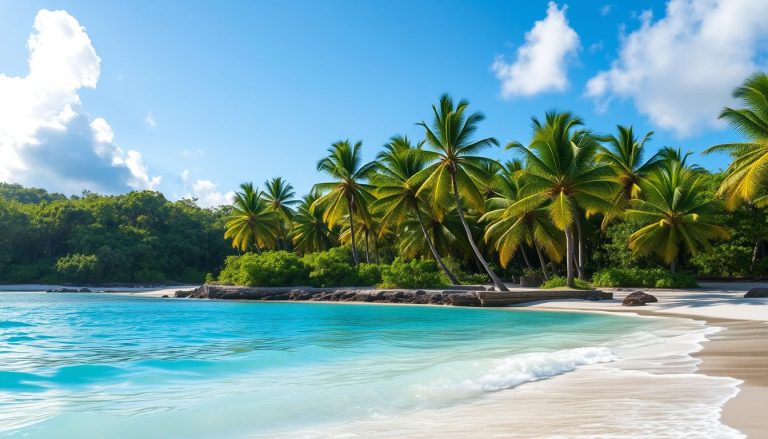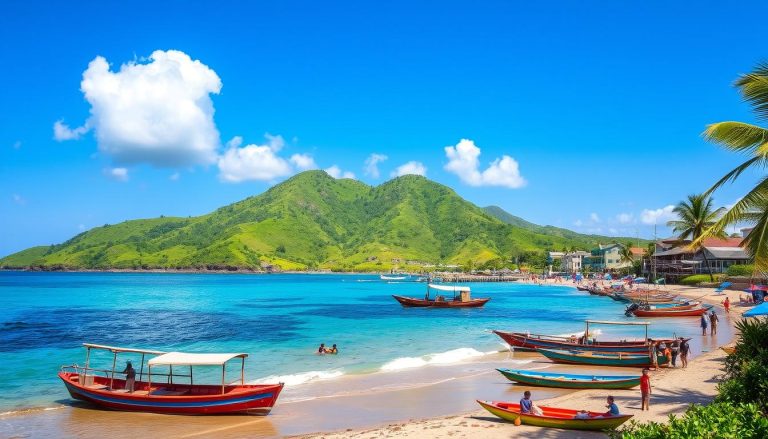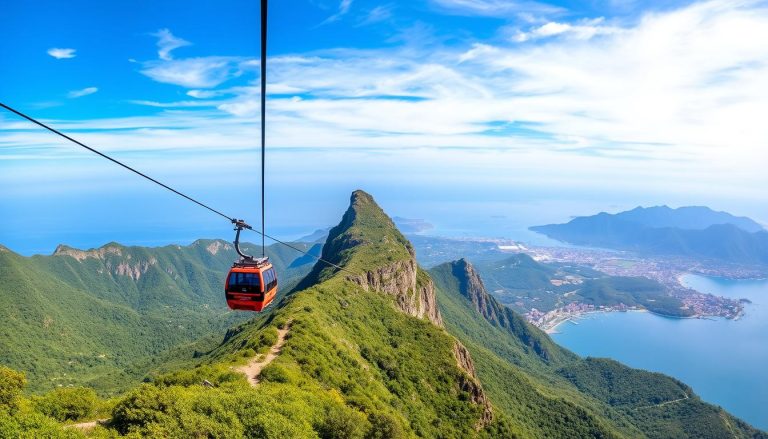Ever wondered what it’s like to see nature’s power and human strength together? Montserrat, the “Emerald Isle” of the Caribbean, is a great place to see this. The Soufrière Hills Volcano is at the center of this island’s story. It has changed the island’s look and the lives of its people.
Montserrat’s volcanic past is both amazing and humbling. Since 1995, people have come to see the volcano’s power and the island’s strength. You can take tours or learn at the Montserrat Volcano Observatory. It’s a chance to learn about this natural wonder.
Key Takeaways
- Explore the dramatic impact of the Soufrière Hills Volcano on Montserrat’s landscape and culture.
- Discover the island’s unique blend of natural beauty and volcanic wonders.
- Immerse yourself in educational experiences at the Montserrat Volcano Observatory.
- Uncover the resilience of Montserrat’s people in the face of natural disasters.
- Venture into the island’s lush northern regions to experience its diverse wildlife and hiking trails.
Are you ready for a journey that shows nature’s power and human strength? Get ready to be amazed by the Soufrière Hills Volcano and Montserrat’s story.
Overview of Montserrat's Volcanic Heritage
Montserrat’s volcanic history has changed its landscape, economy, and culture. The Soufrière Hills Volcano erupted in 1995, after being quiet for centuries. This event changed Montserrat’s path forever.
Historical Background and Volcanic Activity
Monserrat is about 43 km southwest of Antigua and 50 km northwest of Guadeloupe. The Soufrière Hills Volcano has been erupting since 1995. This eruption destroyed Plymouth, the capital, causing many to leave and half the land to be abandoned.
Impact on Island Life and Culture
The eruptions have deeply affected Montserrat’s life and culture. The loss of Plymouth forced people to move, changing the economy. The island’s wildlife, like the Montserrat oriole, has also suffered from the eruptions.
Current Volcanic Status
The Soufrière Hills Volcano is still active, with ups and downs in activity. The Montserrat Volcano Observatory watches the volcano closely. The exclusion zone, where Plymouth once stood, is still closed to visitors, showing the volcano’s power and the island’s strength.
“The volcanic eruption in 2010 destroyed much of the old airport on the island, and thousands of Montserratians sought refuge in Great Britain due to the volcanic eruptions.”
Soufrière Hills Volcano Tours and Viewing Points
Montserrat’s Soufrière Hills Volcano is a must-see for nature lovers. Police-escorted tours let visitors explore the restricted zone. They see the ash-covered landscapes and learn about the island’s strong ecosystem.
Key spots like Jack Boy Hill and the Montserrat Volcano Observatory offer amazing views. Garibaldi Hill also gives a great view of the volcano. These places are perfect for taking photos and videos.
| Viewing Location | Highlight |
|---|---|
| Jack Boy Hill | Offers sweeping views of the volcano and the island’s southern region |
| Montserrat Volcano Observatory | Features scientific monitoring facilities and educational exhibits |
| Garibaldi Hill | Provides a panoramic perspective of the volcano and the surrounding landscape |
These volcano tours and scenic viewpoints show nature’s power and Montserrat’s strength. Seeing the volcano up close is unforgettable. It’s a journey that will stay with you forever.
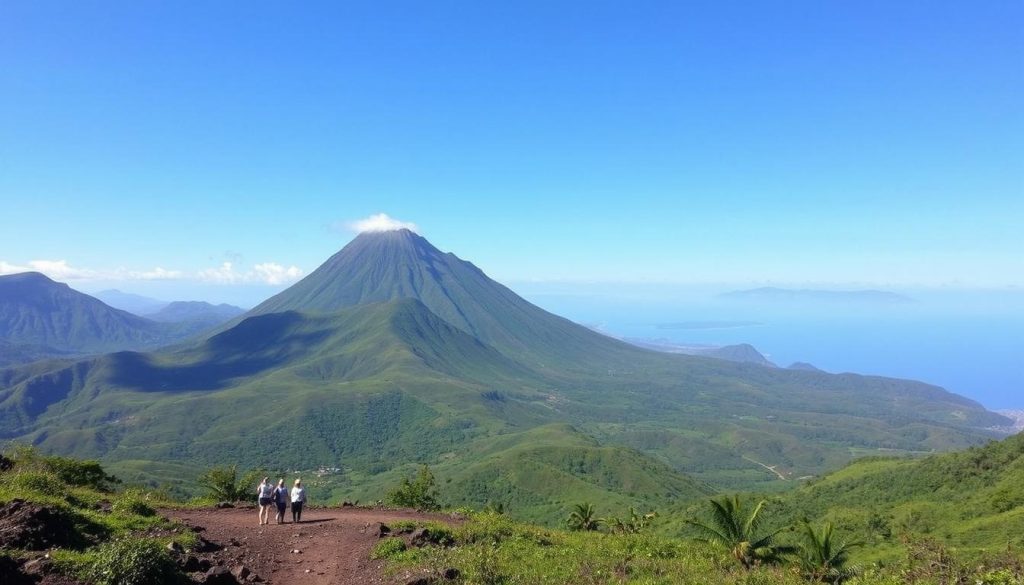
“The Soufrière Hills Volcano is a humbling reminder of the force of nature and the adaptability of the human spirit. Witnessing its impact firsthand is a profoundly moving experience.”
Montserrat Volcano Observatory Experience
The Montserrat Volcano Observatory is in the heart of the volcanic landscape. It offers a deep dive into seismic monitoring and volcanic research. You can see the latest scientific tools and learn about the island’s geological history.
Scientific Monitoring Facilities
At the observatory, you’ll see live seismic activity recordings. It’s a thrilling look at the volcano’s inner workings. Staff will explain how they use these tools to predict eruptions.
Educational Programs and Exhibits
Explore Montserrat’s volcanic past through the observatory’s educational exhibits. The displays and interactive parts tell the story of the island’s disasters. This includes Hurricane Hugo in 1989 and the ongoing eruptions.
Viewing Platforms and Photo Opportunities
The observation deck has stunning views of the Soufrière Hills volcano. You can see the exclusion zone and the abandoned town of Plymouth. It’s perfect for taking amazing photos of the volcano and the green surroundings.
Guided tours by local guides add a personal touch. They share stories of life before and after the eruptions. The Montserrat Volcano Observatory is a key spot for those interested in nature’s power and beauty.
Exploring Plymouth: The Modern Pompeii
Plymouth, on Montserrat’s southern coast, is now half-buried in volcanic ash and mud. It’s called the “Modern Pompeii.” This town was once full of life but was destroyed by the Soufrière Hills Volcano in the late 20th century.
Guided tours show visitors the Plymouth landscape. Buildings are bent and trapped by volcanic flows and mud. It’s a haunting sight, showing the volcano’s power and the island’s history.
Montserrat is now a unique travel spot. It invites visitors to see its historical sites and natural wonders. Plymouth is a key part of this, reminding us of nature’s power and the Montserratian people’s spirit.
“Visiting Plymouth is a truly humbling experience, a reminder of the fragility of our existence and the awe-inspiring forces that shape our world.”
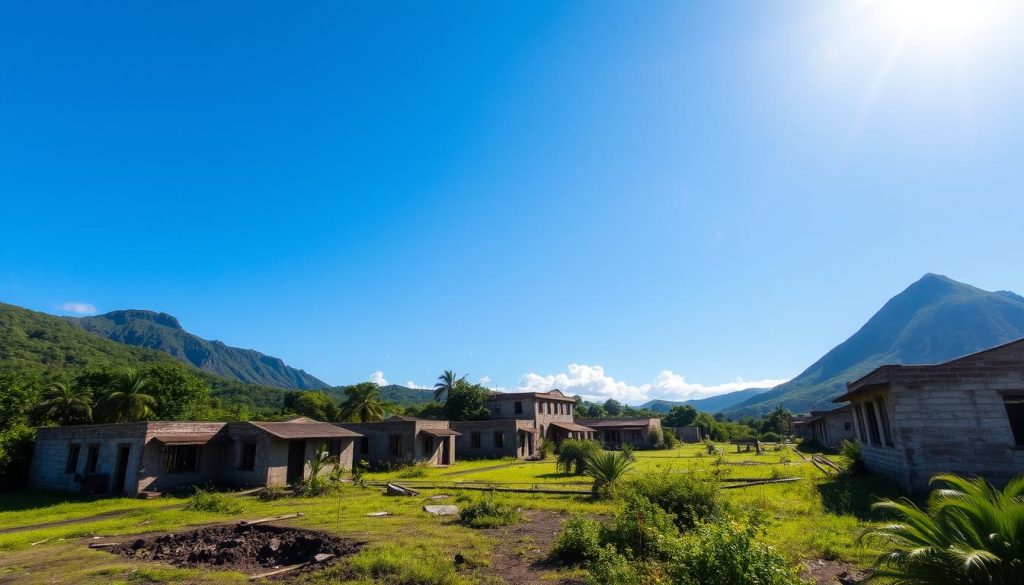
Walking through Plymouth is striking. You see the huge damage from the volcano. Buildings, once full of life, now stand as silent reminders of the island’s past. It’s a moving look at the Montserratian people’s strength and nature’s power.
| Key Facts About Plymouth, Montserrat | Value |
|---|---|
| Population (Pre-Volcanic Eruption) | около 4,000 человек |
| Current Population | 0 (город полностью заброшен) |
| Date of Major Volcanic Eruption | 18 июля 1995 г. |
| Estimated Depth of Volcanic Ash and Mud | до 12 метров |
| Nickname | “Современная Помпея” |
Hiking Adventures in Centre Hills
The Centre Hills in Montserrat are a treasure trove of rainforest trails for hiking. This area is full of endemic species, perfect for birdwatchers and nature lovers. It’s a key part of the island’s eco-tourism scene.
Popular Trail Routes
The Blackwood Allen Trail and the Oriole Walkway are top picks in the Centre Hills. These trails take you through stunning rainforests. Along the way, you might see native wildlife.
- The Blackwood Allen Trail is a 3-hour hike through thick vegetation and tall trees. It’s a deep dive into Montserrat’s rainforest.
- The Oriole Walkway is a 1.5-hour trail. It’s named after the Montserrat oriole. You might see this bird along the way.
Wildlife Spotting Opportunities
The Centre Hills are home to many endemic species. Look out for the Montserrat forest thrush and the oriole. These birds are unique to the island.
| Endemic Species | Habitat | Conservation Status |
|---|---|---|
| Montserrat Oriole | Centre Hills Rainforest | Endangered |
| Montserrat Forest Thrush | Centre Hills Rainforest | Vulnerable |
| Montserrat Galliwasp | Centre Hills Forests | Critically Endangered |
Safety Guidelines and Best Practices
For a safe hike in the Centre Hills, join a guided tour by the Montserrat National Trust. These tours are led by experts. They teach you about the local plants and animals and keep you safe.
Don’t forget to bring the right hiking gear and stay hydrated. Follow all safety rules to enjoy your eco-tourism trip in Montserrat’s Centre Hills.
Beach Activities and Coastal Attractions
Montserrat’s stunning coastline offers a variety of beach experiences. Visit Rendezvous Bay, the island’s only white-sand beach, by boat or a tough hike. Enjoy swimming and snorkeling at Little Bay Beach and Woodlands Bay. You might see sea turtles or whales migrating.
The island’s volcanic history has created black sand beaches against the blue waters. The coastal views are dramatic and breathtaking. It’s a chance to see the island’s natural beauty up close.
Explore Montserrat's Beaches
- Rendezvous Bay: Montserrat’s only white-sand beach, accessible by boat or a challenging hike
- Little Bay Beach: Popular for swimming, snorkeling, and relaxation
- Woodlands Bay: Known for sea turtle nesting and whale watching
Beach activities depend on local conditions and safety rules. Always check with local authorities or tour guides for the latest advice.
| Beach | Key Attractions | Access |
|---|---|---|
| Rendezvous Bay | White-sand beach, snorkeling | Boat or challenging hike |
| Little Bay Beach | Swimming, snorkeling, relaxation | Easily accessible |
| Woodlands Bay | Sea turtle nesting, whale watching | Easily accessible |
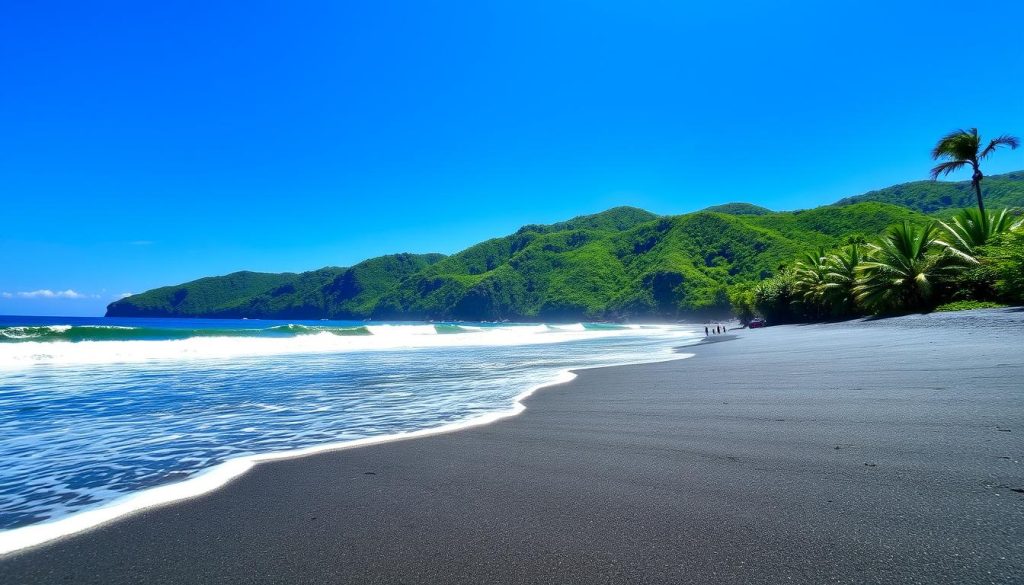
“Montserrat’s coastline offers a unique blend of natural beauty and geological wonders, making it a must-visit destination for those seeking a truly authentic Caribbean adventure.”
Soufrière Hills Volcano, Montserrat: Best Things to Do - Top Picks
Montserrat’s volcanic history is unique and fascinating. When planning your trip, here are some key travel tips and top picks for the Soufrière Hills Volcano.
Essential Visitor Information
Before you start your volcano adventure, check the current activity levels. Also, follow the safety rules from local authorities. The Montserrat Volcano Observatory keeps a close eye on the volcano. They can tell you about any areas you should avoid.
Guided Tour Options
- Join a guided tour of the Soufrière Hills Volcano. It’s a deep dive into the island’s volcanic past and its effect on the community.
- Go on guided hikes in the Centre Hills. You’ll see rare plants and animals and enjoy beautiful views.
- Experience Montserrat’s culture through music, dance, and food. It’s a great way to learn about the island’s heritage.
Photography Locations
Montserrat is a paradise for photographers. You’ll find amazing shots from the Soufrière Hills Volcano to the beautiful coastlines. Here are some must-see spots:
- Jack Boy Hill: It gives you a wide view of the volcano and the landscape.
- Garibaldi Hill: A great spot to see the Soufrière Hills Volcano up close.
- Coastal viewpoints: Visit places like Rendezvous Bay and Little Bay for beautiful coastal photos.
Montserrat’s Soufrière Hills Volcano is a must-see for anyone interested in volcanoes, guided tours, or photography. Plan well and follow local advice for a safe and unforgettable trip.
Water Sports and Marine Activities
Montserrat’s waters are perfect for scuba diving and snorkeling. The coral reefs are full of colorful marine life. It’s a great place for both seasoned divers and snorkeling fans to see the underwater world.
Redonda off Montserrat is a top dive spot. You can see green moray eels and nurse sharks there. The coral reefs are home to many tropical fish, like parrotfish and angelfish.
- Explore the thriving coral reefs and encounter a variety of marine life, including sea turtles and stingrays.
- Discover the hidden wonders of Montserrat’s underwater world through scuba diving and snorkeling adventures.
- Visit the Montserrat Island Dive Centre and Scuba Montserrat at Little Bay for equipment rentals and guided tours catering to all skill levels.
Montserrat offers both exciting dives and calm snorkeling. Dive into the beauty of the coral reefs and meet the lively marine life that lives here.
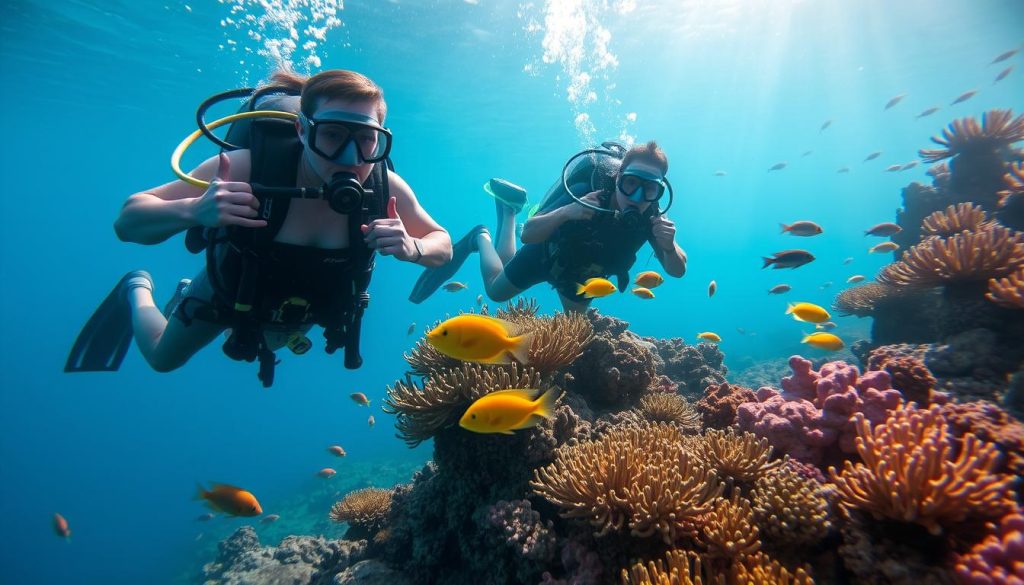
Cultural Heritage Sites and Museums
In the heart of Montserrat, the Montserrat National Trust headquarters is a treasure trove. It offers a deep look into the island’s rich culture. The exhibits cover history, arts, and traditions that have shaped Montserrat over time.
Visitors can also explore the trust’s beautiful botanical gardens. These gardens show off a wide range of plants, both native and exotic. It’s a peaceful spot in the midst of the island’s stunning nature.
The Montserrat National Museum in Little Bay is another key spot. It’s filled with artifacts from pre-Columbian times to today. It’s a fascinating look at how the island has changed over the years.
Music lovers will be drawn to the Montserrat Cultural Centre. It was founded by Sir George Martin. The centre has a top-notch recording studio and hosts many events, including the “Wall of Fame” exhibit. This exhibit features handprints of famous musicians who have visited the island.
| Cultural Attraction | Key Features | Hours of Operation |
|---|---|---|
| Montserrat National Trust | Exhibits on island history, arts, and culture; Botanical gardens with indigenous and exotic flora | Open daily |
| Montserrat National Museum | Artifacts from pre-Columbian times to the present day | Open Monday to Saturday |
| Montserrat Cultural Centre | Recording studio, cultural events, “Wall of Fame” exhibit | Open for scheduled events |
Explore Montserrat’s rich culture by visiting these sites and museums. Learn about the island’s history, see the work of local artists, and experience its musical heritage. Montserrat is known for its vibrant culture and is a must-see destination.
Nature Conservation Areas and Eco-Tourism
Montserrat’s landscapes are full of wildlife, and the island is proud of its conservation work. The Centre Hills and northern areas protect species moved by volcanoes. These places keep Montserrat’s plants and animals safe, like the Montserrat oriole and mountain chicken frog.
Eco-tourism helps these conservation efforts. Visitors can go on nature walks and birdwatching tours. These activities let people see Montserrat’s biodiversity and help protect it. They also support the island’s environmental preservation and wildlife protection.
Protected Zones
The Centre Hills and northern areas are protected zones. They cover over half of Montserrat. These zones are safe for plants and animals and are not developed.
Endemic Species
Montserrat has many unique species, like the Montserrat oriole and mountain chicken frog. These species are protected to keep Montserrat’s biodiversity alive.
Conservation Efforts
Montserrat works hard to keep its nature safe and promote green tourism. The island restores habitats, watches over species, and involves the community. This balance protects Montserrat’s wildlife and nature.
Local Food and Entertainment Spots
Montserrat’s food scene is a mix of Caribbean and international tastes. It focuses on fresh seafood and local produce. You can enjoy authentic island meals at beachside restaurants and cozy eateries. These places offer a wide range of flavors to please everyone.
Montserrat is also famous for its cultural events and entertainment. The Montserrat Festival, from mid-December to early January, is a highlight. It features music, dance, and traditional foods that celebrate the island’s heritage. The Montserrat Cultural Centre hosts various performances and events, showcasing local and international talent.
Montserrat is great for those who love Caribbean food and culture. You can find everything from beachside restaurants to live shows. These spots make your visit to the island unforgettable.

